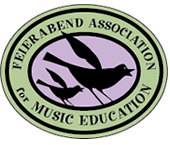“Music in the home”
Dr. John Feierabend
Recently, while in a reflective mood, I found myself thinking about my early childhood music exposure and how I myself learned through the folk song aural process. In the early part of the last century, ethnomusicologists such as Alan Lomax collected folk songs from the musical gold mine that could be found in lower income rural families. And I reflect on how that was not all that much different from how I learned songs in urban Detroit when I was young. At the age of 66, I think back on my childhood and see that it was not all that dissimilar from what Lomax discovered in rural America in how we inherited music.
The Feierabends were “poor folk” living in a housing project called Herman Gardens in Detroit. When I was 7 we moved to a “Levittown” style housing project outside of Detroit (Roseville) until I finished high school. We had no elementary school music teacher, and there were few musical moments in the school in my elementary years. My Kindergarten teacher played piano and taught us songs and dances from Hansel and Gretel. In 4th grade, Ms. Eldred taught us “Swing Low, Sweet Chariot” (with ostinati!) and “Ruben and Rachel.” Outside of school, even though I desperately wanted to take piano, mom and dad started me on accordion lessons in 4thgrade at the local recreation center (50 beginners in one room…accordion was big in Detroit back then). My first public school music class was in 7thgrade in a 6 week choir module.
So, woe is me. Poor kid from Detroit; no music education…BUT…..
Like the “po’ folk” Alan Lomax collected from, I experienced music aurally from my mom, Alice, and also in part from the kids in the projects and subsequent neighborhood (jump rope rhymes, ball bouncing, counting out, hand clapping).
Alice was full of music. She never studied music except in high school where she sang in a Shriner’s girls choir (Grandpa was a Shriner) called “The Rainbow Girls”. During her high school years in the early 1940s she spent several summers at Detroit Recreation summer camp as a counselor/swimming teacher. It was here that she learned and became the embodiment of how music can be used as a means of entertaining and enriching children. Then later, when we kids came along Mom shared those musical gems with us and the neighborhood kids.
Since there was no money, mom shared experiences. She shared the songs and games that she knew and loved. We developed our own creativity as she proposed songs where we were encouraged to make up verses that rhymed in songs like “Oh, You Can’t Get to Heaven.” I remember when I was 5, she taught us the “12 days of Christmas” in the car as we were coming back from the Ford Rotunda Christmas Display. I recall watching her lead kids in singing during the summer on a bus full of housing project kids headed to the beach with songs like, “John Brown’s Baby” or “Be Kind to Your Web-Footed Friends.”
I remember being sung to sleep many nights with “Brahms Lullaby.” She taught me jump rope rhymes and ball bouncing games (“One two three O’Leary-o”) and I learned hand clapping games from her as well (“Peas Porridge Hot”). She loved to dance, whether it was at a wedding or at the local roller skating rink, and often invited me to be her partner. Yes, we were po’ folk, but we spent plenty of quality time engaged in music related activities.
And classical music was in my life through church and vinyl records. I can remember as far back as 4 years old (and until 16 years old) on Sundays mom took my brother Bob and me to the local German Lutheran Church where she sang the hymns in full voice. And I loved listening to the organ preludes and postludes where the music was rich and full of incredible resonance and harmonies.
We got our first record player when I was in 4thgrade. The first record mom bought was Gershwin’s Rhapsody in Blue. I probably listened to that 2-3 times a day for weeks. Soon thereafter, about once a week we made a trip to the local public library that had a collection of classical recordings that could be checked out BY ADULTS ONLY. Mom would send me over to browse the records and then tell her which two to check out (limit 2 a week). I don’t know why I chose what I chose, but I discovered so much beautiful music during those elementary years (I was partial to Brahms).
Of course, I took all this for granted at the time. To what could I compare it? Now I look back and realize how much of my musical development was influenced by my mother and how many of my principles about music education are built on replicating my own personal experience with music. Perhaps this is where the 30-Year Plan originated. I hope all of today’s children become musical adults like my mom, who will give their children the gift my mom gave me, a love of music and its power to connect, soothe, and enrich.
